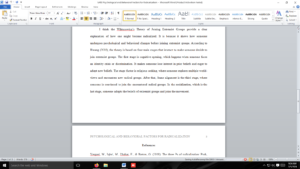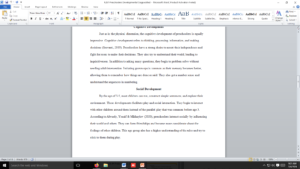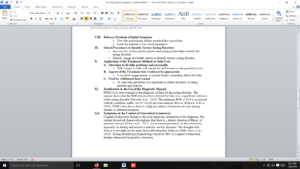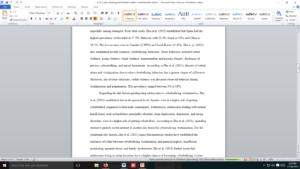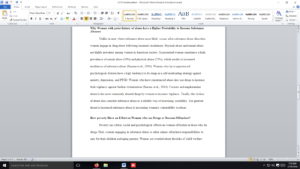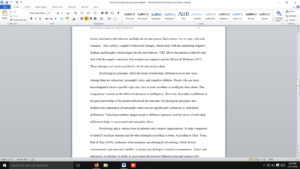“Julia Measuring Up I grew up in a northeastern suburban town, and I’ve lived in the same house for my entire life. My father is a lawyer, and my mother is the assistant principal at our town’s high school. My sister, Holly, is 4 years younger than I am. My parents have been married for almost 20 years. Aside from the usual sort of disagreements, they get along well. In fact, I would say that my entire family gets along well. We’re not particularly touchy-feely: It’s always a little awkward when we have to hug our grandparents on holidays, because we just never do that sort of thing at home. That’s not to say that my parents are uninterested or don’t care about us. Far from it; even though they both have busy work schedules, one of them would almost always make it to my track and cross-country meets and to Holly’s soccer games. My mother, in particular, has always tried to keep on top of what’s going on in our lives. In high school, I took advanced-level classes and earned good grades. I also got along quite well with my teachers, and ended up graduating in the top 10 percent of my class. I know this made my mother really proud, especially since she works at the school. She would get worried that I might not be doing my best and “working to my full potential.” All through high school, she tried to keep on top of my homework assignments and test schedules. She liked to look over my work before I turned it in, and would make sure that I left myself plenty of time to study for tests. Describe the family dynamics and school pressures experienced by Julia. Under what circumstances might such family and school factors become problematic or set the stage for psychological problems? In addition to schoolwork, the track and cross-country teams were a big part of high school for me. I started running in junior high school because my parents wanted me to do something athletic and I was never coordinated enough to be good at sports like soccer. I was always a little bit chubby when I was a kid. I don’t know if I was actually overweight, but everyone used to tease me about my baby fat. Running seemed like a good way to lose that extra weight; it was hard at first, but I gradually got better and by high school I was one of the best runners on the team. Schoolwork and running didn’t leave me much time for anything else. I got along fine with the other kids at school, but I basically hung out with just a few close friends. When I was younger, I used to get teased for being a Goody Two-Shoes, but that had died down by high school. I can’t remember anyone with whom I ever had problems. I did go to the prom, but I didn’t date very much in high school. My parents didn’t like me hanging out with boys unless it was in a group. Besides, the guys I had crushes on were never the ones who asked me out. So any free time was mostly spent with my close girlfriends. We would go shopping or to the movies, and we frequently spent the night at one another’s houses. It was annoying that although I never did anything wrong, I had the earliest curfew of my friends. Also, I was the only one whose parents would text me throughout the night just to check in. I don’t ever remember lying to them about what I was doing or who I was with. Although I felt like they didn’t trust me, I guess they were just worried and wanted to be sure that I was safe. Julia Coping With Stress Now I am 17 years old and in the spring semester of my first year at college. I was awarded a scholar-athlete full scholarship at the state university. I’m not sure of the exact cause of my current problems, but I know a lot of it must have to do with college life. I have never felt so much pressure before. Because my scholarship depends both on my running and on my maintaining a 3.6 grade point average, I’ve been stressed out much of the time. Academic work was never a problem for me in the past, but there’s just so much more expected of you in college. It was pressure from my coach, my teammates, and myself that first led me to dieting. During the first semester, almost all my girlfriends in college experienced the “freshman 15” weight gain—it was a common joke among everyone when we were up late studying and someone ordered a pizza. For some of them it didn’t really matter if they gained any weight, but for me it did. I was having trouble keeping up during cross-country practices. I even had to drop out of a couple of races because I felt so awful and out of shape. I couldn’t catch my breath and I’d get terrible cramps. And my times for the races that I did finish were much worse than my high school times had been. I know that my coach was really disappointed in me. He called me aside about a month into the season. He wanted to know what I was eating, and he told me the weight I had gained was undoubtedly hurting my performance. He said that I should cut out snacks and sweets of any kind, and stick to things like salads to help me lose the extra pounds and get back into shape. He also recommended some additional workouts. I was all for a diet—I hated that my clothes were getting snug. In addition, I was feeling left out of the rest of the team. As a freshman, I didn’t know any of the other runners, and I certainly wasn’t proving myself worthy of being on the team. At that point, I was 5′6″ and weighed 145 pounds. When I started college I had weighed 130 pounds. Both of these weights fell into the “normal” body mass index range of 18.5 to 25, but 145 pounds was on the upper end of normal. Was the advice from Julia’s coach out of line, or was it her overreaction to his suggestions that caused later problems? Dieting was surprisingly easy. The dining hall food bordered on inedible anyway, so I didn’t mind sticking to salads, cereal, or yogurt. Occasionally I’d allow myself pasta, but only without sauce. I completely eliminated dessert, except for fruit on occasion. If anyone commented on my small meals, I just told them that I was in training and gearing up for the big meets at the end of the season. I found ways to ignore the urge to snack between meals or late at night when I was studying. I’d go for a quick run, check Facebook and Twitter, take a nap—whatever it took to distract myself. Sometimes I’d drink water or Diet Coke and, if absolutely necessary, I’d munch on a carrot. Many eating disorders follow a period of intense dieting. Is dieting inevitably destructive? Are there safeguards that can be taken during dieting that can head off the development of an eating disorder? Once I started dieting, the incentives to continue were everywhere. My race times improved, so my coach was pleased. I felt more a part of the team and less like an outsider. My clothes were no longer snug; and when they saw me at my meets my parents said I looked great. I even received an invitation to a party given by a fraternity that only invited the most attractive first-year women. After about a month, I was back to my normal weight of 130 pounds. At first, my plan was to get back down to 130 pounds, but it happened so quickly that I didn’t have time to figure out how to change my diet to include some of the things that I had been leaving out. Things were going so well that I figured it couldn’t hurt to stick to the diet a little longer. I was on a roll. I remembered all the people who I had seen on television who couldn’t lose weight even after years of trying. I began to think of my frequent hunger pangs as badges of honor, symbols of my ability to control my bodily urges. I set a new weight goal of 115 pounds. I figured if I hit the gym more often and skipped breakfast altogether, it wouldn’t be hard to reach that weight in another month or so. Of course this made me even hungrier by lunchtime, but I didn’t want to increase my lunch size. I found it easiest to pace myself with something like crackers. I would break them into several pieces and only allow myself to eat one piece every 15 minutes. The few times I did this in the dining hall with friends I got weird looks and comments. I finally started eating lunch alone in my room. I would simply say that I had some readings or a paper to finish before afternoon class. I also made excuses to skip dinner with people. I’d tell my friends that I was eating with my teammates, and tell my teammates that I was meeting my roommate. Then I’d go to a dining hall on the far side of campus that was usually empty, and eat by myself. I remember worrying about how I would handle Thanksgiving. Holidays are a big deal in my family. We get together with my aunts and uncles and grandparents, and of course there is a huge meal. I couldn’t bear the stress of being expected to eat such fattening foods. I felt sick just thinking about the stuffing, gravy, and pies for dessert. I told my mother that there was a team Thanksgiving dinner for those who lived too far away to go home. That much was true, but then I lied and told her that the coach thought it would be good for team morale if we all attended. I know it disappointed her, but I couldn’t deal with trying to stick to my diet with my family all around me, nagging me to eat more. Julia Spiraling Downward I couldn’t believe it when the scale said I was down to 115 pounds. I still felt that I had excess weight to lose. Some of my friends were beginning to mention that I was actually looking too thin, as if that’s possible. I wasn’t sure what they meant—I was still feeling chubby when they said I was too skinny. I didn’t know who was right, but either way I didn’t want people seeing my body. I began dressing in baggy clothes that would hide my physique. I thought about the overweight people my friends and I had snickered about in the past. I couldn’t bear the thought of anyone doing that to me. In addition, even though I was running my best times ever, I knew there was still room there for improvement. Look back at Case 9, Bulimia Nervosa. How are Julia’s symptoms similar to those of the individual in that case? How are her symptoms different? Around this time, I started to get really stressed about my schoolwork. I had been managing to keep up throughout the semester, but your final grade basically comes down to the final exam. It was never like this in high school, when you could get an A just by turning in all your homework assignments. I felt unbearably tense leading up to exams. I kept replaying scenarios of opening the test booklet and not being able to answer a single question. I studied nonstop. I brought notes with me to the gym to read on the treadmill, and I wasn’t sleeping more than an hour or two at night. Even though I was exhausted, I knew I had to keep studying. I found it really hard to be around other people. Listening to my friends talk about their exam schedules only made me more frantic. I had to get back to my own studying. The cross-country season was over, so my workouts had become less intense. Instead of practicing with the team, we were expected to create our own workout schedule. Constant studying left me little time for the amount of exercise I was used to. Yet I was afraid that cutting back on my workouts would cause me to gain weight. It seemed logical that if I couldn’t keep up with my exercise, I should eat less in order to continue to lose weight. I carried several cans of Diet Coke with me to the library. Hourly trips to the lounge for coffee were the only study breaks I allowed myself. Aside from that, I might have a bran muffin or a few celery sticks, but that would be it for the day. Difficult though it was, this regimen worked out well for me. I did fine on my exams. This was what worked for me. At that point, I weighed 103 pounds and my body mass index was 16.6. Based on your reading of either the DSM-5 or a textbook, what disorder might Julia be displaying? Which of her symptoms suggest this diagnosis? After finals, I went home for winter break for about a month. It was strange to be back home with my parents after living on my own for the semester. I had established new routines for myself and I didn’t like having to answer to anyone else about them. Right away, my mother started in; she thought I spent too much time at the gym every day and that I wasn’t eating enough. When I told her that I was doing the same thing as everyone else on the team, she actually called my coach and told him that she was concerned about his training policies! More than once she commented that I looked too thin, like I was a walking skeleton. She tried to get me to go to a doctor, but I refused. Dinner at home was the worst. My mother wasn’t satisfied when I only wanted a salad—she’d insist that I have a ‘’well-balanced meal” that included some protein and carbohydrates. We had so many arguments about what I would and wouldn’t eat that I started avoiding dinnertime altogether. I’d say that I was going to eat at a friend’s house or at the mall. When I was at home I felt like my mother was watching my every move. Although I was worried about the upcoming semester and indoor track season, I was actually looking forward to getting away from my parents. I just wanted to be left alone—to have some privacy and not be criticized for working out to keep in shape. Was there a better way for Julia’s mother to intervene? Or would any intervention have brought similar results? Since I’ve returned to school, I’ve vowed to do a better job of keeping on top of my classes. I don’t want to let things pile up for finals again. With my practice and meet schedule, I realize that the only way to devote more time to my schoolwork is to cut back on socializing with friends. So, I haven’t seen much of my friends this semester. I don’t go to meals at all anymore; I grab coffee or a soda and drink it on my way to class. I’ve stopped going out on the weekends as well. I barely even see my roommate. She’s asleep when I get back late from studying at the library, and I usually get up before her to go for a morning run. Part of me misses hanging out with my friends, but they had started bugging me about not eating enough. I’d rather not see them than have to listen to that and defend myself. Even though I’m running great and I’m finally able to stick to a diet, everyone thinks I’m not taking good enough care of myself. I know that my mother has called my coach and my roommate. She must have called the dean of student life, because that’s who got in touch with me and suggested that I go to the health center for an evaluation. I hate that my mother is going behind my back after I told her that everything was fine. I realize that I had a rough first semester, but everyone has trouble adjusting to college life. I’m doing my best to keep in control of my life, and I wish that I could be trusted to take care of myself. Julia seems to be the only person who is unaware that she has lost too much weight and developed a destructive pattern of eating. Why is she so unable to look at herself accurately and objectively? Rebecca Losing a Roommate When I first met Julia back in August, I thought we would get along great. She seemed a little shy but like she’d be fun once you got to know her better. She was really cool when we were moving into our room. Even though she arrived first, she waited for me so that we could divide up furniture and closet space together. Early on, a bunch of us in the dorm started hanging out together, and Julia would join us for meals or parties on the weekends. She’s pretty and lots of guys would hit on her, but she never seemed interested. The rest of us would sit around and gossip about guys we met and who liked who, but Julia just listened. From day one, Julia took her academics seriously. She was sort of an inspiration to the rest of us. Even though she was busy with practices and meets, she always had her readings done for class. But I know that Julia also worried constantly about her studies and her running. She’d talk about how frustrating it was to not be able to compete at track at the level she knew she was capable of. She would get really nervous before races. Sometimes she couldn’t sleep, and I’d wake up in the middle of the night and see her pacing around the room. When she told me her coach suggested a new diet and training regimen, it sounded like a good idea. I guess I first realized that something was wrong when she started acting a lot less sociable. She stopped going out with us on weekends, and we almost never saw her in the dining hall anymore. A couple of times I even caught her eating by herself in a dining hall on the other side of campus. She explained that she had a lot of work to do and found that she could get some of it done while eating if she had meals alone. When I did see her eat, it was never anything besides vegetables. She’d take only a tiny portion and then she wouldn’t even finish it. She didn’t keep any food in the room except for cans of Diet Coke and a bag of baby carrots in the fridge. I also noticed that her clothes were starting to look baggy and hang off her. A couple of times I asked her if she was doing okay, but this only made her defensive. She claimed that she was running great, and since she didn’t seem sick, I figured that I was overreacting. Why was Rebecca inclined to overlook her initial suspicions about Julia’s behaviors? Was there a better way for the roommate to intervene? I kept believing her until I returned from Thanksgiving. It was right before final exams, so everyone was pretty stressed out. Julia had been a hard worker before, but now she took things to new extremes. She dropped off the face of the earth. I almost never saw her, even though we shared a room. I’d get up around 8:00 or 9:00 in the morning, and she’d already be gone. When I went to bed around midnight, she still wasn’t back. Her side of the room was immaculate: bed made, books and notepads stacked neatly on her desk. When I did bump into her, she looked awful. She was way too thin, with dark circles under her eyes. She seemed like she had wasted away; her skin and hair were dull and dry. I was pretty sure that something was wrong, but I told myself that it must just be the stress of the upcoming finals. I figured that if there were a problem, her parents would notice it and do something about it over winter break. When we came back to campus in January, I was surprised to see that Julia looked even worse than during finals. When I asked her how her vacation was, she mumbled something about being sick of her mother and happy to be back at school. As the semester got under way, Julia further distanced herself from us. There were no more parties or hanging out at meals for her. She was acting the same way she had during finals, which made no sense because classes had barely gotten going. We were all worried, but none of us knew what to do. One time, Julia’s mother sent me a message on Facebook and asked me if I had noticed anything strange going on with Julia. I wasn’t sure what to write back. I felt guilty, like I was tattling on her, but I also realized that I was in over my head and that I needed to be honest. How might high schools and universities better identify individuals with serious eating disorders? What procedures or mechanisms has your school put into operation? I wrote her mother about Julia’s odd eating habits, how she was exercising a lot and how she had gotten pretty antisocial. Her mother wrote me back and said she had spoken with their family doctor. Julia was extremely underweight, even though she still saw herself as chunky and was afraid of gaining weight. A few days later, Julia approached me. Apparently she had just met with one of the deans, who told her that she’d need to undergo an evaluation at the health center before she could continue practicing with the team. She asked me point-blank if I had been talking about her to anyone. I told her how her mother had contacted me and asked me if I had noticed any changes in her over the past several months, and how I honestly told her yes. She stormed out of the room and I haven’t seen her since. I know how important the team is to Julia, so I am assuming that she’ll be going to the health center soon. I hope that they’ll be able to convince her that she’s taken things too far, and that they can help her to get better. How might the treatment approaches used in Cases 2, 4, and 9 be applied to Julia? How should they be altered to fit Julia’s problems and personality? Which aspects of these treatments would not be appropriate? Should additional interventions be applied?”
